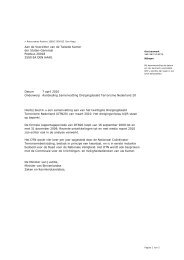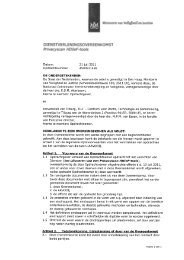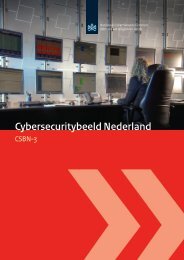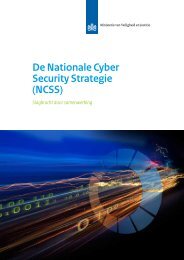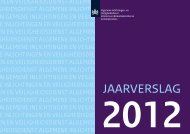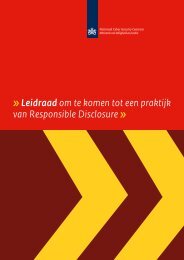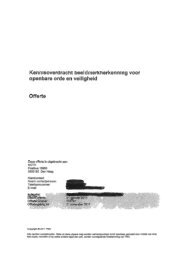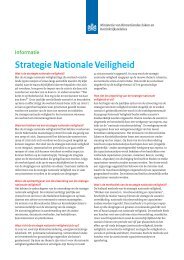third Cyber Security Assessment Netherlands - NCSC
third Cyber Security Assessment Netherlands - NCSC
third Cyber Security Assessment Netherlands - NCSC
You also want an ePaper? Increase the reach of your titles
YUMPU automatically turns print PDFs into web optimized ePapers that Google loves.
Classification<br />
Classified data<br />
Cloud/Cloud services<br />
Compromise<br />
Confidentiality<br />
Cookie<br />
COTS<br />
CPNI.NL<br />
CVE<br />
<strong>Cyber</strong> crime<br />
<strong>Cyber</strong> security<br />
Data breach/data leak<br />
De-Googling<br />
DCS<br />
(D)DoS<br />
DigiD<br />
DNS<br />
DNSSEC<br />
Establishing which data constitute special information and specifying the level of security necessary<br />
for this information.<br />
Data, including documents or materials that a party or user identifies as in need of protection against<br />
unlawful publication, identified as such in a security classification.<br />
An internet (the ‘cloud’) based model for system architecture that mainly involves the use of Software<br />
as a Service (SaaS).<br />
Familiarisation, or the possibility for an unauthorised party to familiarise himself, with classified<br />
information.<br />
A quality characteristic of data in the context of information security. Confidentiality can be defined<br />
as a situation in which data may only be accessed by someone with the authorisation to do so. The<br />
owner of the data in question will decide who will have this authorisation.<br />
A cookie is information that a web server saves on the end-user’s computer. This information can then<br />
be retrieved by the web server the next time the end-user connects to the server. Cookies can be used<br />
to save user settings or to track the user.<br />
Commercial Off-The-Shelf (COTS) refers to ready-to-use software and hardware products on sale<br />
to the public.<br />
Centre for Protection of the National Infrastructure (CPNI.NL) is the Dutch platform for cyber security,<br />
facilitated by the TNO.<br />
Common Vulnerabilities and Exposures (CVE) is a unique common identification of publicly known data<br />
security vulnerabilities.<br />
Form of criminality that targets an IT system or the information it processes.<br />
<strong>Cyber</strong> security protects against the danger of harm caused by the misuse, disruption, or failure of IT.<br />
The danger or harm can cause restrictions to the availability and reliability of systems, and infringement<br />
of confidentiality or harm to the integrity of information stored on the systems.<br />
The intentional or unintentional release of confidential data.<br />
Removing information on people or businesses from the internet with the aim of ensuring that this<br />
content no longer appears in search results.<br />
The <strong>Cyber</strong> <strong>Security</strong> Directorate (DCS), including the <strong>NCSC</strong>, is part of the NCTV.<br />
(Distributed) Denial of Service term for a type of attack in which a particular service (e.g. a website)<br />
becomes unavailable to the usual consumers of the service. DoS attacks on websites are often performed<br />
by bombarding websites with huge amounts of network traffic, so that they become unavailable.<br />
Contraction of Digital Identity, used to identify and authenticate citizens on government websites.<br />
It allows government institutions to ascertain whether they are really dealing with the individual<br />
in question.<br />
The Domain Name System (DNS) links internet domain names to IP addresses and vice versa. For<br />
example, the web address or URL (uniform resource locator) named ‘www.ncsc.nl’ represents IP address<br />
‘62.100.52.109’.<br />
DNS <strong>Security</strong> Extensions (DNSSEC) add authenticity and integrity controls to the existing DNS system.<br />
106



